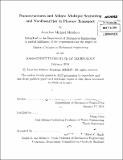Nanostructures and alloys : multiple scattering and nonlinearities in phonon transport
Author(s)
Mendoza, Jonathan Michael
DownloadFull printable version (11.14Mb)
Alternative title
Multiple scattering and nonlinearities in phonon transport
Other Contributors
Massachusetts Institute of Technology. Department of Mechanical Engineering.
Advisor
Gang Chen.
Terms of use
Metadata
Show full item recordAbstract
Understanding how thermal transport is affected by disorder is crucial to the prediction and engineering of novel materials suitable for thermoelectric and device applications. Ab initio methods have demonstrated accurate calculations of the lattice contribution to thermal conductivity in semiconductors and dielectrics. Effective field theories and scattering theory have been combined to model alloys and systems with embedded nanostructures. The simplest of such effective field theories, the Virtual Crystal approximation, fails to capture short-length scale information due to the inherent coarse graining of the approximation. Additionally, these methods do not take multiple scattering effects into account. In order to address these issues, Green's function methods are developed to handle multiple scattering phenomena in systems with large numbers of impurities. Explicit calculations from the Green's functions method are able to capture the deviation from the dilute alloy limit in disordered systems. Multiple scattering theory developed in this thesis allows for a more precise description of the interaction between phonons and nanostructures. The phonon Green's function is computed from the dispersion relation obtained from Density Functional Theory. Multiple scattering theory predicts resonance scattering that is not accounted for in first order theory. Understanding how these resonances behave in large disordered systems yields insight into thermal transport in alloys. When impurities become closely spaced, the resonances couple and broaden over a range of frequencies that depends upon the strength of the coupling and the number of impurities. These resonant states become significantly coupled in silicon germanium alloys of concentrations over ten percent. Scattering rates, angle dependent scattering amplitudes, and local density of states calculations are subsequently performed for nanostructured germanium slabs embedded in a silicon host. The strong coupling between the densely packed system of impurities causes significant broadening over a wide range of phonon frequencies. The strong coupling highlights the importance of using Green's functions to capture high frequency effects. Furthermore, scattering rate calculations as a function of frequency highlight the transition from the Rayleigh regime to the geometric limit. Although approximations exist that describe the low and high frequency behavior, the transition between the two regimes requires multiple scattering theory. The lowest frequency peak in the nanostructure density of states corresponds to the transition frequency between the long and short wavelength asymptotic limits. Angle dependent scattering also provides insight into the transition between the Rayleigh and high frequency limits. The scattering phase functions exhibit isotropic scattering at long wavelengths, which are characteristic of the Rayleigh regime. As phonon frequencies increase, the scattering profile takes on a much more anisotropic profile reminiscent of interfacial scattering at frequencies away from the band edge. High frequency phonon scattering is reminiscent of particle scattering off of hard boundaries.
Description
Thesis: S.M., Massachusetts Institute of Technology, Department of Mechanical Engineering, 2014. Cataloged from PDF version of thesis. Includes bibliographical references (pages 95-102).
Date issued
2014Department
Massachusetts Institute of Technology. Department of Mechanical EngineeringPublisher
Massachusetts Institute of Technology
Keywords
Mechanical Engineering.